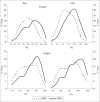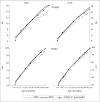Secular trends in growth of preschool children from rural Maharashtra, India
- PMID: 23304908
- PMCID: PMC3763613
- DOI: 10.3329/jhpn.v30i4.13325
Secular trends in growth of preschool children from rural Maharashtra, India
Abstract
The study examined the secular trends in growth of preschool children from rural Maharashtra, India, during 1985-2001. Anthropometric data collected on preschool (< 6 years old) children during 2001 (n = 1,171) and 1985 (n = 979) from the same villages were compared. Decadal change increased with age and was marginally higher in boys than girls. It was the lowest among infants (-0.1 to 0.1 kg and 0.4 to 0.7 cm in both sexes) and the highest among boys of 4+ years (1.3 kg and 2.9 cm) and girls of 5+ years (1.2 kg and 2.1 cm). Increase in weight was higher (10-15%) compared to that in height (3-5%) and, consequently, reduction in the prevalence of wasting was marked (around 68% in boys and 48% in girls) than that in stunting (42% in boys and 27% in girls) among these children. The improvement was higher in boys than in girls. Negligible secular changes in younger children indicate the need for creating health and nutritional awareness among rural mothers while relatively higher improvement in weight than height among older children warns the future possibility of childhood adiposity even among rural populations.
Figures





Similar articles
-
Stunting, underweight and wasting among Integrated Child Development Services (ICDS) scheme children aged 3-5 years of Chapra, Nadia District, West Bengal, India.Matern Child Nutr. 2007 Jul;3(3):216-21. doi: 10.1111/j.1740-8709.2007.00099.x. Matern Child Nutr. 2007. PMID: 17539890 Free PMC article.
-
Nutritional status of rural children in the Lesotho Highlands.East Afr Med J. 1997 Nov;74(11):680-9. East Afr Med J. 1997. PMID: 9557436
-
Prevalence and determinants of undernutrition among under-five children residing in urban slums and rural area, Maharashtra, India: a community-based cross-sectional study.BMC Public Health. 2020 Oct 16;20(1):1559. doi: 10.1186/s12889-020-09642-0. BMC Public Health. 2020. PMID: 33066763 Free PMC article. Clinical Trial.
-
Prevalence of malnutrition in Kenya.East Afr Med J. 1999 Jul;76(7):376-80. East Afr Med J. 1999. PMID: 10520364
-
Patterns of stunting and wasting: potential explanatory factors.Adv Nutr. 2012 Mar 1;3(2):227-33. doi: 10.3945/an.111.001107. Adv Nutr. 2012. PMID: 22516733 Free PMC article. Review.
Cited by
-
Secular trends in weight, height and weight for height among children under 7 years in nine cities of China, 1975-2015: results from five repeated cross-sectional surveys.BMJ Open. 2019 Oct 30;9(10):e029201. doi: 10.1136/bmjopen-2019-029201. BMJ Open. 2019. PMID: 31666262 Free PMC article.
-
Taller but thinner: trends in child anthropometry in Senegal, 1990-2015.Public Health Nutr. 2020 Sep;23(13):2365-2372. doi: 10.1017/S1368980019003598. Epub 2020 Jan 3. Public Health Nutr. 2020. PMID: 31896380 Free PMC article.
References
-
- Zhen-Wang B, Cheng-Ye J. Secular growth changes in body height and weight in children and adolescents in Shandong, China between 1939 and 2000. Ann Hum Biol. 2005;32:650–65. - PubMed
-
- Danker-Hopfe H, Roczen K. Secular trends in height, weight and body mass index of 6-year-old children in Bremerhaven. Ann Hum Biol. 2000;27:263–70. - PubMed
-
- Shatrugna V, Rao KV. Secular trends in the heights of women from the urban poor community of Hyderabad. Ann Hum Biol. 1987;14:375–7. - PubMed
-
- Singh SP, Malhotra P. Secular shift in menarcheal age of Patiala (India) schoolgirls between 1974 and 1986. Ann Hum Biol. 1988;15:77–80. - PubMed
-
- Kapoor S, Kapoor AK, Bhalla R, Singh IP. Parent-offspring correlation for body measurements and subcutaneous fat distribution. Hum Biol. 1985;57:141–50. - PubMed
Publication types
MeSH terms
LinkOut - more resources
Full Text Sources
Medical
